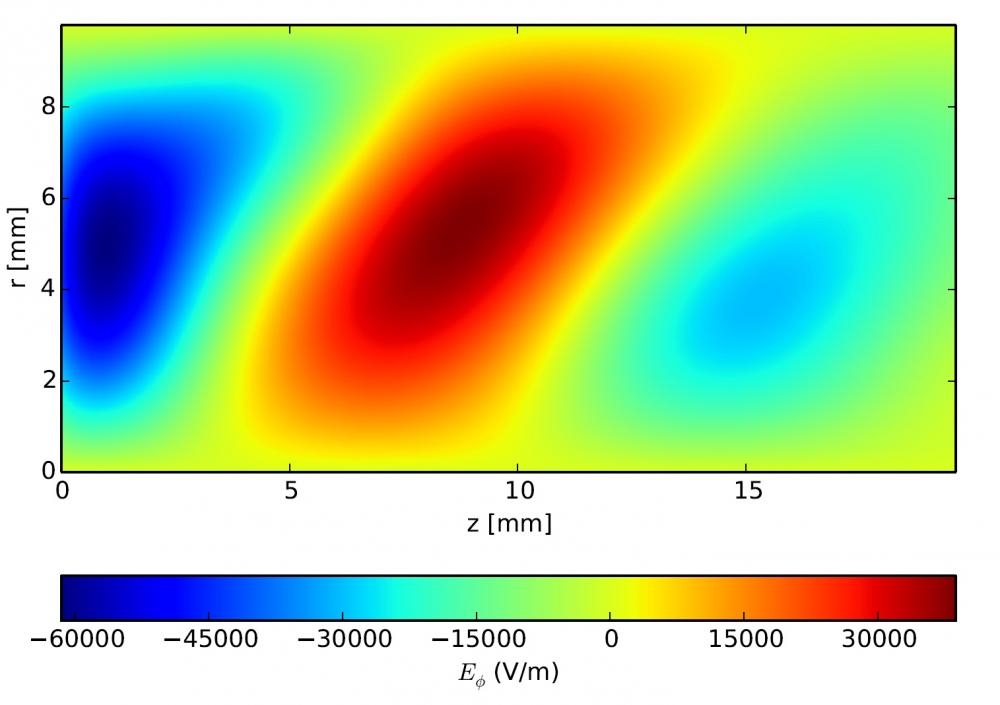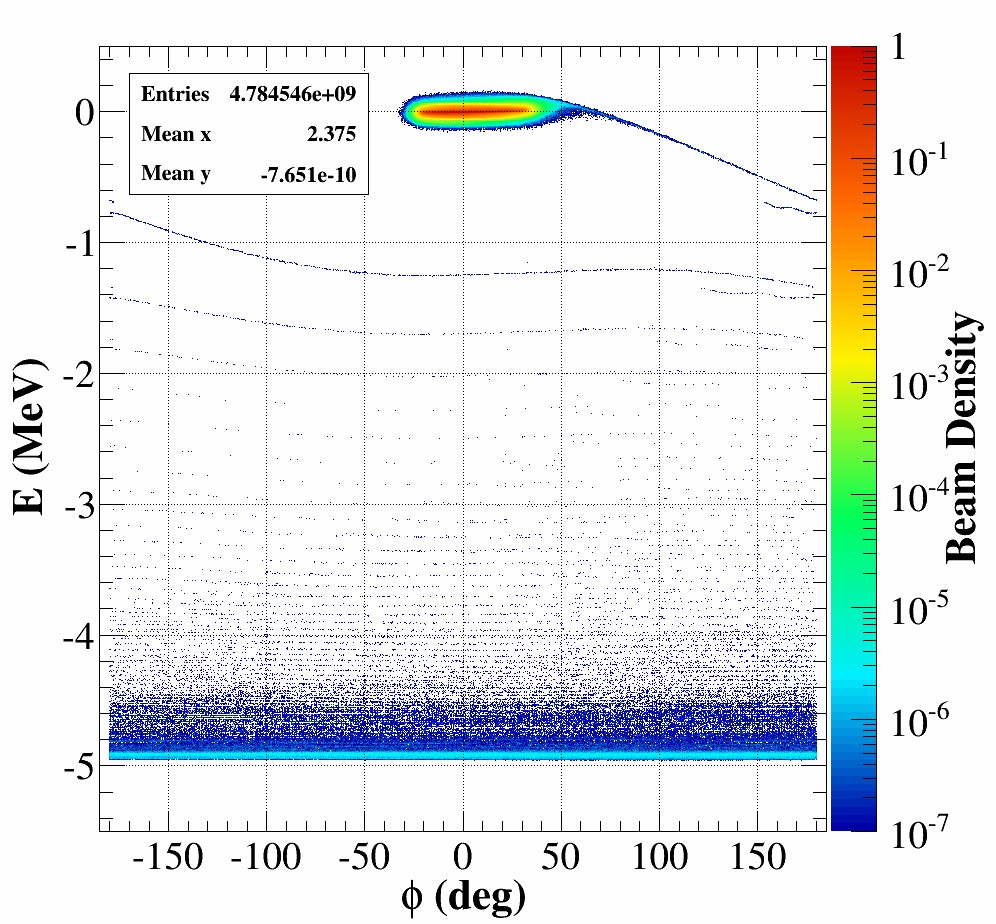Beam dynamics may be defined as the study of charged particle motion in static or time varying electromagnetic fields. These fields may be external or induced by the particle distribution. In the case of electrons, the effect of synchrotron radiation must also be taken into consideration. Obtaining an accurate model of beam dynamics raises many problems. Examples at the fundamental level include interactions with the residual gas, interactions with solid interfaces, the dynamics of ion source plasmas, beam optics in the presence of high-order electromagnetic components such as hexapoles and octupoles, and the control of halo formation and beam losses for the maintenance of future high-power accelerators. Overcoming these problems involves the development of analytical models and numerical methods that exploit available computer resources to the full. The validity of proposed models must then be tested by comparison with experimental results.
Beam simulation in electron cyclotron resonance sources
SACM has been developing ECR (Electron Cyclotron Resonance) light ion sources since the 1990s, mainly for accelerators. Our first ECR model, the SILHI source, can generate up to 100 mA of protons or deutons. Various sources have since been built to suit project requirements (SPIRAL2 at Ganil, FAIR at GSI, IFMIF-LIPAc at Rokkasho). A wide variety of parameters has been explored with extracted currents ranging from 5 mA to 140 mA, and beam energies from 20 keV to 100 keV, continuous or pulsed, with different magnet configurations (coils or permanent magnets).
Optimization of the ECR sources is a key issue and much effort has been expended to make more compact and cheaper sources with better performance. The ALISES ion source was developed with this aim. The influence of different parameters such as plasma chamber radius and length has been studied, giving SACM recognized expertise in this field.
In parallel, important research has been carried out on these sources using modeling and simulations; this has shed light on problems observed experimentally and has therefore led to improvements in the efficiency of ECR sources. However, the current tools still have limitations and certain phenomena, such as the influence of the plasma chamber radius, are still not properly understood. It is still difficult to model plasma chambers because of the neutrality of the medium, the strong wave-plasma coupling, collisions in the plasma and conditions at the limits (beam extraction). For this reason SACM has set up an R&D program to model plasma dynamics in partnership with Pantechnik.

Illustration of wave-plasma coupling at electron cyclotron resonance. The azimuth component of the electric field is represented by color level. The simulation is performed axisymmetrically along the z axis. In the absence of plasma, the wave is flat along z. The figure shows the wave-plasma coupling.
Particle transport in a low energy lines
One of the current challenges with high-intensity accelerators (with a beam power in the megawatt range) is beam dynamics in low energy beam transport (LEBT) lines. In a LEBT, the dynamic of the beam is dominated by the space charge field (an electromagnetic field self-induced by the beam), which is generally non-linear and can induce halo phenomena, emittance growth and beam loss. Fortunately, a beam propagating in a low energy line causes ionization of the residual gas in that line. Secondary particles (electrons or ions) created by this phenomenon that have an opposite charge to the beam ions, compensate for the effects of space charge. However, this compensation for space charge is only partial and is not uniform throughout the space; it is also time-dependent (a transient phase occurs before equilibrium is established). To improve understanding of the space charge compensation phenomenon, self-consistent numerical simulations need to be performed using dedicated computer codes such as WARP.
Experimental campaigns are also being run to provide data for validating the numerical modeling results. Measurements of the beam characteristics have been made under different experimental conditions (gas type, pressure, focusing) with low energy lines of the linear accelerators of MYRRHA (Horizon 2020) (see LEBT simulation above), IFMIF-LIPAc and with the BETSI test bench. All these activities have been carried out as part of a thesis begun in November 2014.
Particle transport in the medium and high energy sections
Beyond the radio frequency quadrupole, the problems caused by the space charge are less significant, but the level of beam losses must still be controlled in order to minimize the power dissipated in the cryostat components and the activation of the accelerator structures. Beam power in high power machines can reach several megawatts, and the main challenge is to develop extremely accurate calculation methods to estimate the probabilities of very low losses, which can often be well below one watt (see graph opposite). SACM has focused its efforts on developing simulation codes that are capable of defining the highest performance accelerators and of carrying out large-scale simulations based on the most realistic description of the accelerator, including tuning and construction errors. The reliability studies must also include an estimation of the impact of the failure of one or more accelerator components, and of any measures taken to reduce the consequences of such failure.
SACM is involved in a large number of projects that demand every aspect of its expertise. These include IFMIF, Beta-Beams, MYRRHA, EURISOL, LINAC4, SPL, ESS, SPIRAL2, ILC and S3.

Longitudinal distribution at the exit of the IFMIF accelerator RFQ produced during a simulation of the accelerator with the actual number of particles present in a bunch (4.7 109 particles). This simulation involved 170 processors during two weeks to complete and required 40 terabytes of storage. In particular, one can observe the distribution of particles with a large energy difference by respect to the nominal energy, i.e. the particles that have been detached from the beam core. This is difficult to see with more traditional simulations.
Laser plasma acceleration
Plasma acceleration can achieve gradients of up to 100 GV/m over lengths from one millimeter to a meter, depending on the characteristics of the laser used. Electron beams of several hundred MeV can therefore be created with a source of several centimeters. However, the quality of these beams in terms of charge, energy spectrum and emittance mean that they cannot currently be used for colliders. A major R&D effort is consequently being made in this field to improve beam properties. For several years SACM has been part of the Interdisciplinary Center for Extreme Light (CILEX) project at CEA Orme des Merisiers in Saclay, which involves a large number of partners from Université Paris-Saclay. This project aims to create a facility around one 10 PW laser (one of the most powerful lasers in the world) and a set of other lasers. SACM is involved in the creation of a transfer line between the two accelerator stages, which will reveal whether a multi-staged accelerator is possible. As a foundation for this, SACM is also participating in the DACTOMUS project, a preparatory stage to develop the injector. SACM took part in setting up a line to characterize the ELISA electron source (divergence and energy spectrum) on the UHI100 laser, a local laser at CEA Saclay. Finally, SACM is involved in the European Horizon 2020 EuPRAXIA project, which is a design study to create a compact accelerator based on plasma technology. SACM will be a participant in both the acceleration simulation in the plasma chamber and the study of the electron transfer lines between the different accelerator stages.
LHC UPGRADE
As part of the HL-LHC project, SACM is contributing to beam dynamics research, which aims to increase the LHC’s beam brightness by a factor of five by 2020. Using the Achromatic Telescopic Squeezing approach developed by Stéphane Fartoukh at CERN, this improvement will require the modification of only two interaction regions. One of these modifications requires the replacement of the NbTi quadrupoles in the final focusing triplets with quadrupoles manufactured from Nb3Sn. The second requires the use of crab cavities in order to reduce the effect of the beam crossing angle on brightness. SACM is participating in the development of the lattice and has proposed a structure which would reduce the voltage requirement of the crab cavities by 25%. SACM is also involved in studies to specify the tolerances for new components, which will affect the long-term stability of the beam.
Applications for beam transport software
The development of these codes began in 1995 and since 2000, they have been used by many laboratories in the majority of high intensity accelerator studies throughout the world. The predictability of these codes has been verified by experimental comparisons carried out at SNS in the USA, J-PARC in Japan, and GSI in Germany. This suite of professional software is now distributed under license from the CEA via a download website that promotes the software to internet search engines: http://irfu.cea.fr/Sacm/logiciels/index.php
• Accelerator physics and technology › R&D and Instrumentation for Future Accelerators
• Accelerators, Cryogenics and Magnetism Division (DACM)
• LEDA
